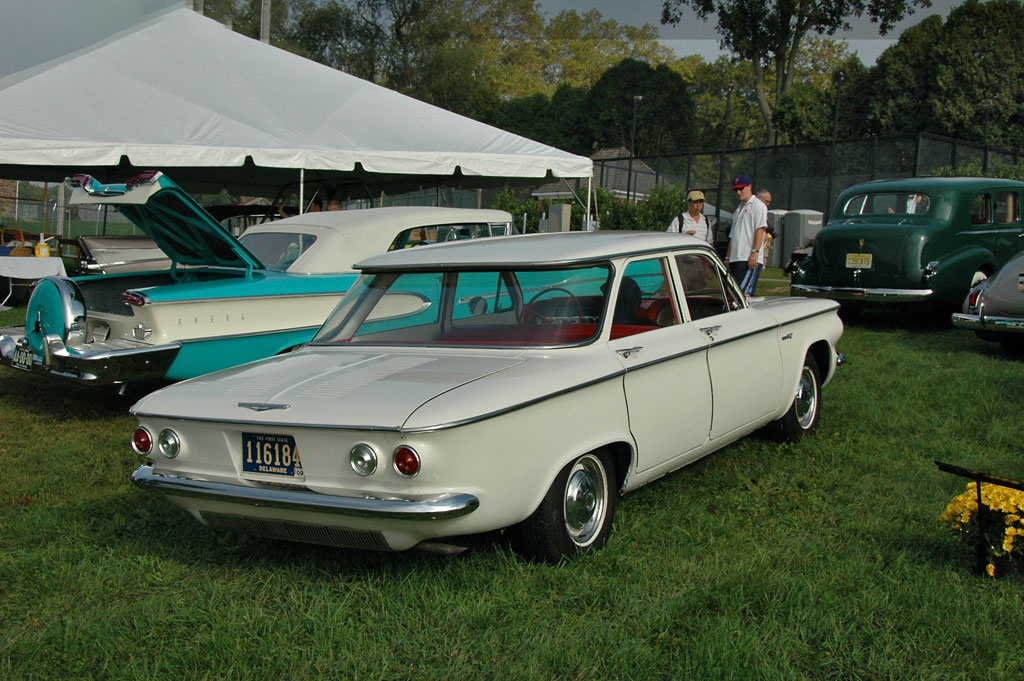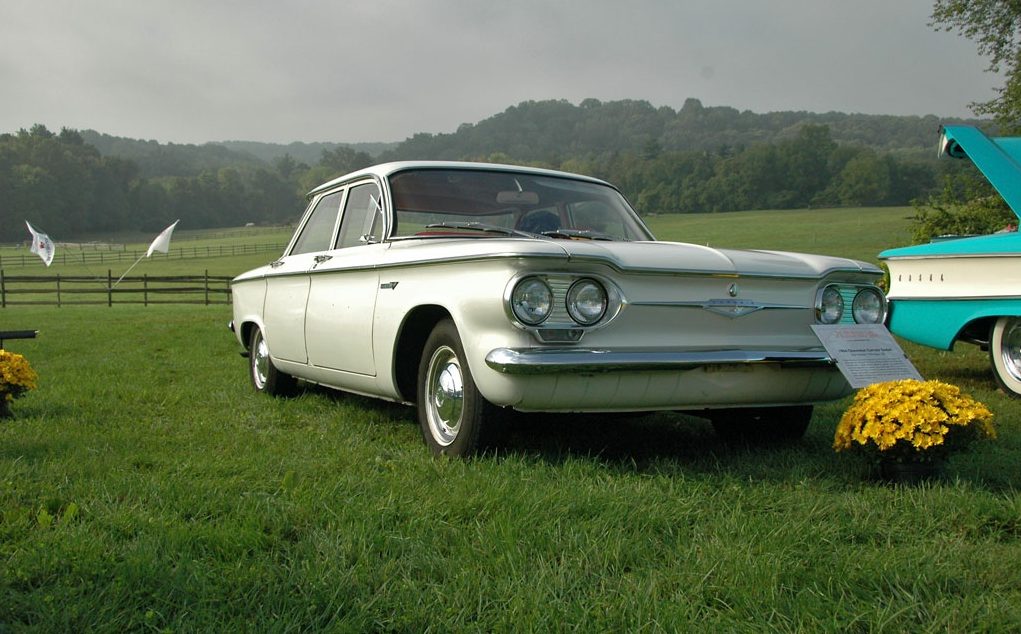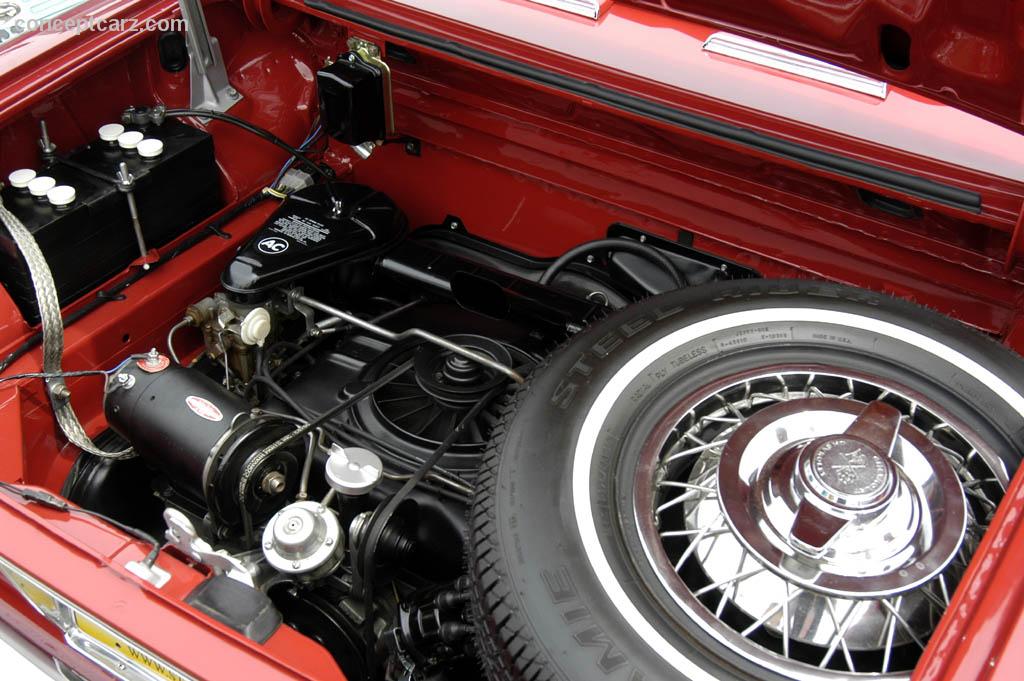The 1964 Chevrolet Corvair Series 700 Series DeLuxe Sedan holds a unique place in automotive history. As an economy sedan, it initially competed with other compact cars like the Ford Falcon and Plymouth Valiant. However, what set the Corvair apart was its groundbreaking engineering approach. With an air-cooled flat opposed 4- or 6-cylinder rear-mounted engine, it showcased innovation and provided a glimpse into future GM styling themes. Despite its early success, the Corvair faced challenges from the emergence of ‘pony’ cars and the infamous book by Ralph Nader, “Unsafe At Any Speed,” ultimately leading to its discontinuation in 1969.
The Innovative Engineering of the Corvair
One of the standout features of the Corvair was its all-aluminum engine, which contributed to its lightweight and durable construction. Road and Track magazine praised the Corvair for its exceptional design. However, Ralph Nader, a well-known critic of automobile safety, disagreed. In his book, “Unsafe At Any Speed,” Nader highlighted safety concerns and the lack of standards in the United States. He specifically targeted the Corvair, claiming that the rear wheels would “tuck under” during turns, resulting in a potential rollover. Although some of these issues were addressed in the 1964 model, Nader remained adamant that the Corvair was still the “leading candidate for the unsafest car title.”
The Battle with Ralph Nader and General Motors
Nader’s book attracted significant attention, leading to legal disputes between him and General Motors. In an attempt to discredit Nader, General Motors investigated his background but found no incriminating evidence. This situation only made General Motors appear more guilty, and as a result, Corvair sales plummeted from 220,000 in 1965 to a mere 14,800 in 1968. The following year, the decision was made to discontinue the production of the Corvair.
The Corvair Monza: The Sporty Model of the Corvair Lineup
Among the four original Corvair models, the Monza convertible option stood out as the sportiest. In 1964, it came with a factory price of $2,492, offering a 164 cubic-inch engine capable of producing 110 horsepower. The Monza’s attractive design and performance appealed to those seeking a youtaful and dynamic driving experience.
The Rise of Compact Cars and the Corvair’s Impact
During the 1950s, the “Big Three” automakers (Chrysler, Ford, and GM) primarily focused on intermediate and full-size vehicles. However, the recession of 1957 prompted consumers to seek more affordable and economical options. American Motors experienced a boost in sales during this period, prompting other automakers to explore the compact car market. By the early 1960s, the Big Three had introduced their own compact models, featuring smaller designs and four- or six-cylinder engines.
Chevrolet, led by General Manager Ed Cole, took a revolutionary approach and introduced the Corvair. With its air-cooled, rear-mounted engine, compact automatic transaxle, and unibody construction, the Corvair defied convention. It boasted independent suspension, wide low-profile tires, and elegant styling without the excessive use of chrome. The engineering and design innovations earned the Corvair accolades, including being named the 1960 Motor Trend ‘Car of the Year.’
The 1964 Chevrolet Corvair: Changes and Challenges
The 1964 model year marked the final year of the original styling introduced in 1960. Sales of the Corvair dipped due to increasing competition, including from within the Chevrolet brand itself. The introduction of the Chevy II, with its conservative styling and front-engine layout, appealed to buyers seeking contemporary designs. Additionally, Ford’s Mustang, launched in mid-1964, captivated the market with its youthful and sporty image. Safety concerns related to the Corvair’s handling issues also contributed to its declining popularity.
The 1964 Corvair Series 500 served as the base trim level, priced at $2,000. It featured essential amenities such as electric wipers, a heater and defroster, rubber floor mats, and front armrests. The Series 700 DeLuxe Sedan, priced at $2,120, offered additional chrome exterior moldings, upgraded interior, and fender model nameplates. The Corvair Monza Series 900 showcased wider rocker panel moldings, full wheel covers, and trim moldings along the wheel cutouts. It came in various body styles, including a two-door club coupe, a sedan, and a convertible. The Monza Monza Spyder Series 600 had distinguishing features like a turbocharged engine and special badges.
Conclusion
The 1964 Chevrolet Corvair Series 700 DeLuxe Sedan played a significant role in automotive history. Its innovative engineering, distinct styling, and early success marked it as a trailblazer in the American automobile industry. However, safety concerns and competition from other models led to its eventual discontinuation. The Corvair remains an iconic and controversial car, forever remembered for its impact on automotive design and safety standards.
FAQs (Frequently Asked Questions)
1. Is the Corvair still in production? No, the production of the Corvair ceased in 1969.
2. What were the main safety concerns with the Corvair? The main safety concerns revolved around the Corvair’s handling, particularly during turns, which could potentially lead to rollovers.
3. How many Corvairs were produced between 1960 and 1969? A total of 1,786,243 Corvairs were produced during that period.
4. What led to the decline in Corvair sales? Factors such as competition from other models, safety concerns, and the release of Ralph Nader’s book “Unsafe At Any Speed” contributed to the decline in Corvair sales.
5. Are there any surviving Corvairs today? Yes, there are still many Corvairs in existence today, with dedicated enthusiasts and collectors keeping the legacy alive.









































